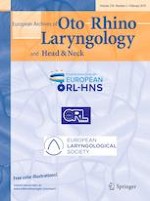Erschienen in:

07.12.2018 | Otology
Wide diameter bone-anchored hearing system implants: a comparison of long-term follow-up data between tissue reduction and tissue preservation techniques
verfasst von:
Martin Reznitsky, Kirsten Wielandt, Søren Foghsgaard
Erschienen in:
European Archives of Oto-Rhino-Laryngology
|
Ausgabe 2/2019
Einloggen, um Zugang zu erhalten
Abstract
Objective
To present long-term data on the Wide Ponto implant bone-anchored hearing system (BAHS) in regards to implant stability, soft tissue reaction and implant loss for two case series undergone either the tissue reduction- or the tissue preservation surgical technique.
Methods
Comparison of two consecutive, prospective case series. Each case series enrolled 24 patients. The case series underwent one-stage implantation of the Wide Ponto implant BAHS using either a linear incision technique with subcutaneous reduction or a linear incision technique without subcutaneous reduction. Implant stability quotient (ISQ) values were measured using resonance frequency analysis and soft tissue reactions were graded according to Holgers’ classification system. Follow-up visits were performed at 10 days, 6 weeks, 6 months, 12 months and annually up to 4 years (tissue preservation) or 5 years (tissue reduction) postoperatively.
Results
The two case series had homogenous patient populations and followed an identical postoperative scheme. The ISQ values increased consistently the first 12 months for both groups (p ≤ 0.001), and were higher in the tissue preservation case series, (p = 0.04, 9 mm abutment). More than 91% of the soft tissue observations were assessed as Holgers’ grade 0 or 1. One implant (2.1%) was lost due to trauma.
Conclusion
In both case series, the Wide Ponto implant showed increasing implant stability during the follow-up period from the time of surgery, irrespective of surgical technique, indicating good osseointegration. Soft tissue reactions were rare and of minor severity. Implant survival was high.











